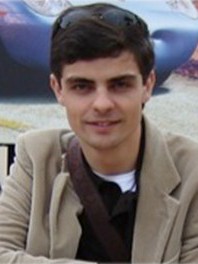abstract
A coarse-grained (CG) model is developed to reproduce the early stages of the templated synthesis of periodic mesoporous organosilicas (PMO), focusing on benzene as the organic linker. Molecular dynamics simulations of hexadecyltrimethylammonium bromide (CTAB) surfactant in aqueous organosilicate solutions were performed to analyze the micelle formation, growth and aggregation during the synthesis of surfactant-templated PMOs. The CG model parameters were calibrated to reproduce radial density profiles of all-atom CTAB spherical micelles in a solution with benzenesilicates (BZS). Our simulations, with over a thousand surfactants, reproduced the experimental micelle aggregation, promoted and driven by the BZS moieties. The micelle sphere-to-rod transition and the subsequent formation of a hexagonally ordered mesophase were observed and characterized, displaying rod diameters (in the range 38-41 angstrom) very close to experimental estimates (38 angstrom). Furthermore, the addition of BZS to a CTAB aqueous solution with spherical micelles at equilibrium promoted the formation of prolate-shaped rods, in accordance with experiments. Subsequent removal of the BZS from the final PMO structure caused the system to revert to the original spherical micelles. In our simulations, the CTAB rods were formed above a 1:5 BZS/CTAB ratio while a ratio of 1:2 was found to be required to induce the hexagonal arrangement of the rods. Overall, this work reinforces the active and cooperative role of organosilicates in the formation of PMO materials. (C) 2020 Elsevier B.V. All rights reserved.
keywords
MOLECULAR-DYNAMICS SIMULATION; COARSE-GRAINED MODEL; TEMPLATED SYNTHESIS; ORGANOSILICA; SURFACTANTS; AGGREGATION; TRANSITIONS; COUNTERION; MICELLES; NEUTRON
subject category
Chemistry; Physics
authors
Gouveia, JD; Perez-Sanchez, G; Santos, SM; Carvalho, AP; Gomes, JRB; Jorge, M
our authors
acknowledgements
The research carried out at the CICECO -University of Aveiro Institute of Materials was developed within the scope of projects UIDB/50011/2020, UIDP/50011/2020 and CENTRO-01-0145-FEDER-31002 (SILVIA), financed by the Portuguese Fundacao para a Ciencia e a Tecnologia (FCT/MCTES), and co-financed by the European Regional Development Fund (FEDER) under the PT2020 Partnership Agreement. Thanks are also due to Red Espanola de Supercomputacion for enabling access to Mare Nostrum supercomputer (Barcelona) through project QS-2019-2-0034. German Perez-Sanchez acknowledges the national funds (OE), through FCT -Fundacao para a Ciencia e a Tecnologia, I.P., in the scope of the framework contract foreseen in the numbers 4, 5 and 6 of the article 23, of the Decree-Law 57/2016, of August 29, changed by Law 57/2017, of July 19. The authors thank Dr. M. A. O. Lourenco for discussions about the experimental synthesis of PMO materials.





